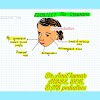MCQ related to pediatric metabolic disorders
Answer after last question
1-Which disease is characterized by recurrent hypoglycemia attacks with hepatomegaly that do not respond to epinephrine or glucagon?
a) Von-Gierke's disease
b) Pompe's disease
c) Mc Ardle's disease
d) Galactosemia
2-Which disease is characterized by coarse facies, hepatosplenomegaly, and tall QRS complex?
a) Von-Gierke's disease
b) Pompe's disease
c) Mc Ardle's disease
d) Galactosemia
3-Which disease is characterized by muscle cramps with myoglobinuria?
a) Von-Gierke's disease
b) Pompe's disease
c) Mc Ardle's disease
d) Galactosemia
4-Which disease is characterized by vomiting, distended abdomen, diarrhea, and reducing sugar in the urine?
a) Von-Gierke's disease
b) Pompe's disease
c) Galactosemia
d) Hereditary fructose intolerance
5-Which disease is caused by a deficiency in galactose-1-phosphate uridyl transferase and can lead to conjugated hyperbilirubinemia, seizures, and cataract in children?
a) Von-Gierke's disease
b) Pompe's disease
c) Galactosemia
d) Hereditary fructose intolerance
6-Which disease is characterized by hypoglycemia, hepatomegaly, and reducing sugar in the urine after ingestion of fructose?
a) Von-Gierke's disease
b) Pompe's disease
c) Galactosemia
d) Hereditary fructose intolerance
7-Which disease is due to biotin deficiency and can cause infantile refusal to feed, vomiting, seizures, ketoacidosis, and skin manifestations?
a) Multiple carboxylase deficiency
b) Organic acidemia
c) Phenylketonuria
d) Maple syrup urine disease
8-Which disease can cause intractable seizures, skin rash, and lactic acidosis with hyperammonemia?
a) Multiple carboxylase deficiency
b) Organic acidemia
c) Phenylketonuria
d) Maple syrup urine disease
9-Which disease is caused by a deficiency in phenylalanine hydroxylase, and the treatment of choice is a low phenylalanine diet?
a) Multiple carboxylase deficiency
b) Organic acidemia
c) Phenylketonuria
d) Maple syrup urine disease
10-Which test in urine of phenylketonuria gives a green color, and the urine has a mousy odor?
a) FeCl3 test
b) Benedict's test
c) Nitroprusside test
d) Tollens' test
11-Which disease is caused by a deficiency in alpha-keto acid decarboxylase, which leads to the blocked metabolism of branched-chain amino acids, and the FeCl3 test in urine gives a blue color?
a) Multiple carboxylase deficiency
b) Organic acidemia
c) Phenylketonuria
d) Maple syrup urine disease
12-Which disease is caused by a deficiency in glucocerebrosidase?
a) Gaucher's disease
b) Tay-Sachs disease
c) Hunter's syndrome
d) Fabry's disease
13-What is the cause of Tay-Sachs disease?
a) Deficiency in glucocerebrosidase
b) Deficiency in hexosaminidase-A (alpha subunit)
c) X-linked recessive mutation
d) Adrenal calcification
14-Which lysosomal storage disorders affect males and are X-linked recessive?
a) Gaucher's disease and Tay-Sachs disease
b) Hunter's syndrome and Fabry's disease
c) Krabbe's disease and Wilson's disease
d) Wolman disease and Canavan's disease
15-What can be seen on imaging in Krabbe's disease?
a) Adrenal calcification
b) Bilateral deep bright thalamic appearance
c) Massive aminoaciduria
d) Hepatosplenomegaly
16-What are the characteristic features of Wilson's disease?
a) Recurrent urinary stones
b) Bilateral deep bright thalamic appearance
c) Emotional liability and brown discoloration of the Descemet membrane of the cornea
d) Adrenal calcification with hepatosplenomegaly, jaundice, abdominal distension, and anemia
17-Which disease is characterized by adrenal calcification with hepatosplenomegaly, jaundice, abdominal distension, and anemia?
a) Gaucher's disease
b) Tay-Sachs disease
c) Hunter's syndrome
d) Wolman disease
18-Canavan's disease is characterized by what physical feature?
a) Bilateral deep bright thalamic appearance
b) Adrenal calcification
c) Macrocephaly
d) Brown discoloration of the Descemet membrane of the cornea
19-What metabolic disorders are associated with mental retardation?
a) Gaucher's disease and Tay-Sachs disease
b) Cystinuria and Wilson's disease
c) Homocystinuria and histidinemia
d) Hartnup disease and oxaluria
20-What is the characteristic feature of cystinuria?
a) Bilateral deep bright thalamic appearance
b) Recurrent urinary stones
c) Massive aminoaciduria
d) Adrenal calcification
21-What conditions are pyridoxin-dependent?
a) Cystinuria and Wilson's disease
b) Homocystinuria and oxaluria
c) Krabbe's disease and Fabry's disease
d) Gaucher's disease and Tay-Sachs disease
22-What is the characteristic feature of Hartnup disease?
a) Bilateral deep bright thalamic appearance
b) Recurrent urinary stones
c) Macrocephaly
d) Massive aminoaciduria of multiple neutral amino acids without an increase in neutral AA in blood
1-Answer: a) Von-Gierke's disease
2-Answer: b) Pompe's disease
3-Answer: c) Mc Ardle's disease
4-Answer: c) Galactosemia
5-Answer: c) Galactosemia
6-Answer: d) Hereditary fructose intolerance
7-Answer: a) Multiple carboxylase deficiency
8-Answer: b) Organic acidemia
9-Answer: c) Phenylketonuria
10-Answer: a) FeCl3 test
11-Answer: d) Maple syrup urine disease
12-Answer: a) Gaucher's disease
13-Answer: b) Deficiency in hexosaminidase-A (alpha subunit)
14-Answer: b) Hunter's syndrome and Fabry's disease
15-Answer: b) Bilateral deep bright thalamic appearance
16-Answer: c) Emotional liability and brown discoloration of the Descemet membrane of the cornea, and it is associated with reduced ceruloplasmin, increased serum copper, increased urinary excretion of copper, and increased liver copper.
17-Answer: d) Wolman disease
18-Answer: c) Macrocephaly
19-Answer: c) Homocystinuria and histidinemia
20-Answer: b) Recurrent urinary stones
21-Answer: b) Homocystinuria and oxaluria
22-Answer:d) Massive aminoaciduria of multiple neutral amino acids without an increase in neutral AA in blood





0 Comments